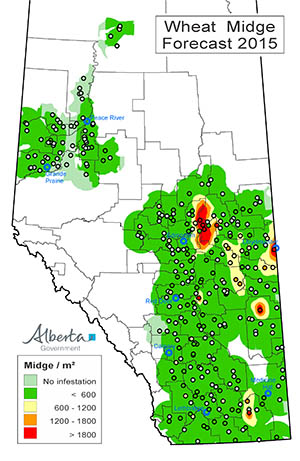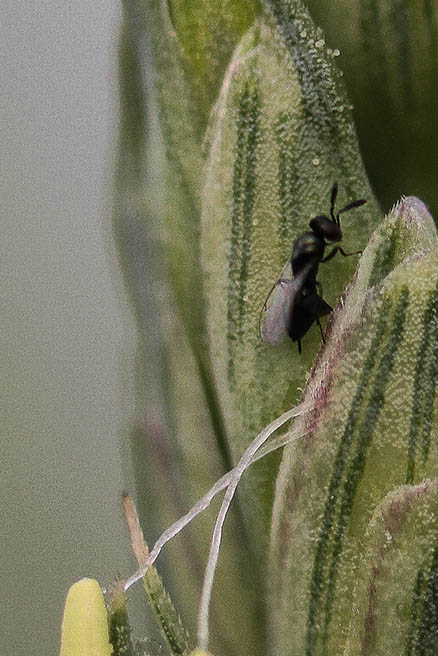| |
 . .
Environmental factors affecting midge | Parasitism | Management tools for dealing with midge | Further information links | How the survey was done | Who helped .
The wheat midge forecast for 2015 shows a collapse of the extreme populations in the eastern Peace Region. Caution must be taken in interpreting this due to the potential for residual populations from the very high levels of the 2013 crop year. Wheat midge has not followed our forecasts very well in the Peace region.
Central Alberta has shown a general increase in wheat midge risk with several areas of particular concern east of Edmonton.
The population has fallen to very low numbers in much of southern Alberta with the exception of some irrigated fields in the County of Forty Mile.
Producers should pay attention to midge downgrading in their wheat samples and use this as a further indication of midge risk in their fields. Over the past several years the field to field variation is very considerable throughout the province, especially in those areas with higher counts. |
 |
Individual fields throughout Alberta may still have economic levels of midge. Each producer also needs to assess their risk based on indicators specific to their farm.
This forecast is not intended to take the place of individual field monitoring. The forecast for Alberta shows areas of risk for midge damage in 2015. It is important to note that over such a wide range, populations in individual fields can be and often are highly variable. Wheat is susceptible to wheat midge from the time the head is visible, even just a little bit, until anthesis (the anthers sticking out). Producers should plan to monitor their fields when the midge adults are flying and their wheat the susceptible stage. For an individual wheat head this is about a week, but for the crop as a whole it would be longer because of later tillers. Regular field scouting on multiple nights in succession is important in understanding the population in a particular field.
Environmental factors affecting midge
Although a number of factors influence the overwintering survival of the midge, the survey and map provide a general picture of existing densities and the potential for infestation in 2015. Weather conditions, specifically temperature and moisture will ultimately determine the extent and timing of midge emergence during the growing season. Temperature and wind also play critical roles in egg laying activities of the adult female wheat midge. The level of damage from wheat midge is determined by the synchrony of wheat midge emergence and wheat coupled with the number of wheat midge.
Parasitism

Macroglens penetrans | Parasitism of midge larvae by a small wasp species (Macroglens penetrans) has been important in keeping wheat midge populations below the economic threshold in many areas. These beneficial wasps tend to thrive in warm, dry conditions. Parasite populations increase and decrease with changes in the midge population and are very important in moderating population levels in Alberta.
It is important to understand that once midge has established in an area it unlikely to ever completely disappear. Low lying and moist areas in a field provide a refuge, enabling the population to survive even when conditions are not favorable in the rest of the field. These low population levels, however, also help sustain a population of natural enemies. |
Management tools for dealing with midge
Important links
How the survey was done
The 2014 fall survey included wheat growing areas throughout Alberta. In total 310 samples were taken from 61 counties. The survey involves taking soil samples from wheat fields after harvest using a standard soil probe. Larval cocoons are washed out of the soil using a specialized series of screens. Larvae are counted, and then dissected to determine if they are parasitized. The midge density displayed on the forecast map is based on viable (live, non-parasitized) midge larvae.
Who helped
The wheat midge survey was conducted by Alberta Agriculture and Rural Development with assistance from:
Thank you David Giffen, Agriculture and Agri-Food Canada, Saskatoon for building the map.
Thank you to the many producers for permission to survey their fields.
Updates of current conditions and wheat midge emergence will be available through the Ag-Info Centre (310 FARM) during the 2014 growing season. |
|